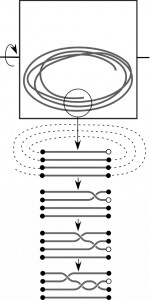Physicists finally explain why your earphones are always tangled.
Posted on Categories Discover Magazine

Photo: Flickr/Steven Guzzardi
[Note from the authors of “Seriously, Science?”: After nine years with Discover, we’ve been informed that this will be our last month blogging on this platform. Despite being (usually) objective scientists, we have a sentimental streak, and we have spent the last few days reminiscing about the crazy, and often funny, science we have highlighted. Therefore, we have assembled a month-long feast of our favorite science papers. Enjoy!]
There are few day-to-day events that send me into a rage as quickly as a pair of tangled earphones. As soon as I put them down, they somehow thread themselves into an unholy mess. And don’t even think about putting them into your pocket or bag. So how do headphones (and other stringy objects) get so knotted in such a short time? To find out, these physicists started by tumbling strings of different stiffness in a box. They found that “complex knots often form within seconds” (so it’s not just my imagination!), and that stiffer strings are less likely to get knotted up. They then used these data and computer simulations to explain how the knots are likely formed (see figure below); basically, when jostled, the strings tend to form coils, and then the loose end weaves through the other strands, much like braiding or weaving. And voila! Tangled headphones to make your day just that much angrier.
Spontaneous knotting of an agitated string.
“It is well known that a jostled string tends to become knotted; yet the factors governing the “spontaneous” formation of various knots are unclear. We performed experiments in which a string was tumbled inside a box and found that complex knots often form within seconds. We used mathematical knot theory to analyze the knots. Above a critical string length, the probability P of knotting at first increased sharply with length but then saturated below 100%. This behavior differs from that of mathematical self-avoiding random walks, where P has been proven to approach 100%. Finite agitation time and jamming of the string due to its stiffness result in lower probability, but P approaches 100% with long, flexible strings. We analyzed the knots by calculating their Jones polynomials via computer analysis of digital photos of the string. Remarkably, almost all were identified as prime knots: 120 different types, having minimum crossing numbers up to 11, were observed in 3,415 trials. All prime knots with up to seven crossings were observed. The relative probability of forming a knot decreased exponentially with minimum crossing number and Möbius energy, mathematical measures of knot complexity. Based on the observation that long, stiff strings tend to form a coiled structure when confined, we propose a simple model to describe the knot formation based on random “braid moves” of the string end. Our model can qualitatively account for the observed distribution of knots and dependence on agitation time and string length.”

Schematic illustration of the simplified model for knot formation. Because of its stiffness, the string tends to coil in the box, as seen in Fig. 1, causing a number of parallel string segments to lie parallel adjacent the end segment. As discussed in the text, we model knots as forming due to a random series of braid moves of the end segment among the adjacent segments (diagrams at bottom). The overall connectivity of the segments is indicated by the dashed line.
Related content:
NCBI ROFL: Will this research untangle scientific mysteries? I’m a frayed knot!
NCBI ROFL: Domestic cats do not show causal understanding in a string-pulling task.
NCBI ROFL: No way. According to my tongue, that hole is definitely wider. (That’s what she said.)